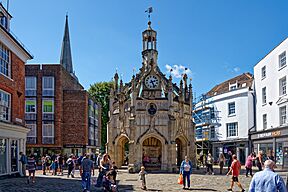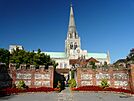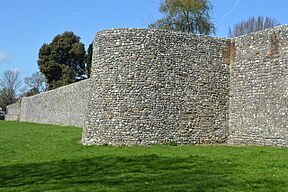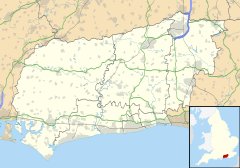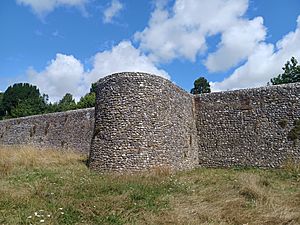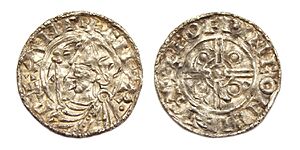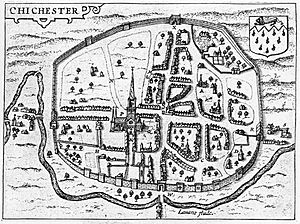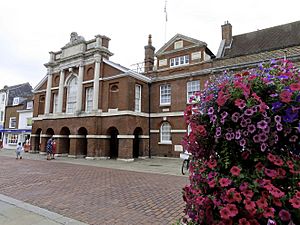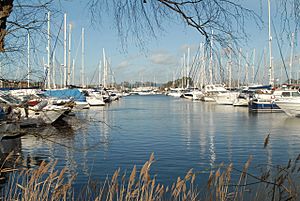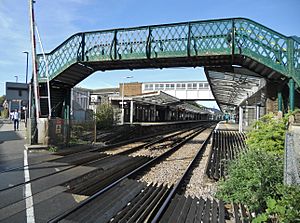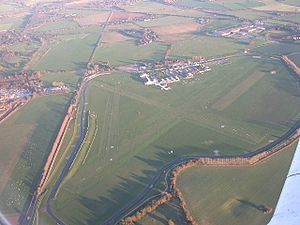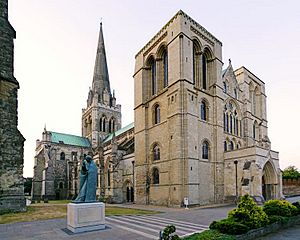Chichester facts for kids
Quick facts for kids Chichester |
|
|---|---|
| City and civil parish | |
|
|
|
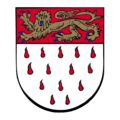 Coat of arms granted in 1570 |
|
| Area | 10.67 km2 (4.12 sq mi) |
| Population | 29,407 (2021 Census) |
| • Density | 2,756/km2 (7,140/sq mi) |
| Demonym | Cicestrian |
| OS grid reference | SU86060482 |
| • London | 54 miles (87 km) NNE |
| Civil parish |
|
| District |
|
| Shire county | |
| Region | |
| Country | England |
| Sovereign state | United Kingdom |
| Post town | CHICHESTER |
| Postcode district | PO19 |
| Dialling code | 01243 |
| Police | Sussex |
| Fire | West Sussex |
| Ambulance | South East Coast |
| EU Parliament | South East England |
| UK Parliament |
|
| Website | City Council |
Chichester (![]() i/ˈtʃɪtʃɪstər/ chitch-IST-ər) is a historic city in West Sussex, England. It is the only city in West Sussex and is its main town. Chichester has been an important place for trade and settlement since Roman and Anglo-Saxon times. Today, it is home to a beautiful 12th-century cathedral.
i/ˈtʃɪtʃɪstər/ chitch-IST-ər) is a historic city in West Sussex, England. It is the only city in West Sussex and is its main town. Chichester has been an important place for trade and settlement since Roman and Anglo-Saxon times. Today, it is home to a beautiful 12th-century cathedral.
The city has two main waterways. These are the Chichester Canal and the River Lavant. The River Lavant is a special type of stream called a winterbourne. It flows south of the city walls and is mostly hidden underground near the city centre.
Contents
- Chichester's Long History
- How Chichester is Governed
- Chichester's Geography and Climate
- People in Chichester
- Chichester's Economy
- Culture and Arts in Chichester
- Local Media
- Famous Landmarks in Chichester
- Getting Around Chichester
- Education in Chichester
- Religion in Chichester
- Sports and Leisure in Chichester
- Famous People from Chichester
- Public Services in Chichester
- Images for kids
- See also
Chichester's Long History
How Did Chichester Begin?
Chichester was not a big settlement before the Romans arrived. The area was important during the Roman invasion in AD 43. This is shown by military buildings found near Fishbourne Roman Palace. The city centre you see today is built on top of the Roman city of Noviomagus Reginorum. This was the capital of the local Roman area.
Roman Roads and City Design
The main Roman road, Stane Street, started at the east gate. It connected Chichester to London. Another Roman road linked Chichester to Silchester from the north gate. The city's layout, with North, South, East, and West streets meeting in the middle, comes from the Romans. The central market cross was added later, in medieval times.
The original Roman city wall was very thick, about 6.5 feet. It had a deep ditch that was later used to move the River Lavant. This wall lasted over 1,500 years! A thinner wall was built in the Georgian period.
Roman Discoveries in Chichester
Roman baths were found under Tower Street when a new car park was being built. A museum called The Novium opened in 2012 to protect these baths.
An amphitheatre was built outside the city walls around 80 AD. Today, this area is a park. You can still see the oval shape of the amphitheatre as a gentle bank. A sign in the park tells you more about it.
In 2017, archaeologists found the well-preserved ground floor of a Roman townhouse. This was in Priory Park. The site was saved because it belonged to a monastery and was never built on after Roman times.
Chichester in Anglo-Saxon Times
The story says that Ælle and his three sons took over the area in the late 400s. The city was supposedly named Chichester after his son, Cissa. It was said to be the main city of the Kingdom of Sussex. However, historians think this story is a myth. There is no proof that Chichester was lived in again after the Romans left until the 800s.
Building Forts for Protection
In the 800s, Alfred the Great built a system of fortified towns called burhs. This was to protect against Viking attacks. Old Roman settlements with strong walls were used for this. Chichester was rebuilt as a burh around 878–879.
The Burghal Hidage is an old Anglo-Saxon document. It lists over thirty burhs and how much tax they paid for their upkeep. For every five units of land (called hides), a town had to provide one armed soldier. One person from every hide also had to help build and guard the burhs. Chichester was a large burh, rated at 1500 hides.
A system of hilltop beacons was used to give early warnings. It is thought that one of these links ran from Chichester to London.
Chichester in Norman Times
After the Norman conquest, the cathedral was moved from Selsey to Chichester. This happened because a church meeting in 1075 decided that important church centres should be in cities.
When the Domesday Book was made, Chichester had about 300 homes and 1,500 people. There was also a mill called Kings Mill. After the Battle of Hastings, Chichester was given to Roger de Mongomerie. He was rewarded for his bravery in battle.
Chichester Castle was built around 1066 to help the Normans control the area. In 1216, the French captured Chichester Castle. It was taken back the next year, and the king ordered the castle to be destroyed.
Chichester from Medieval to Victorian Times
Around 1400, Bishop Robert Reed built a cross in the Market Place. This is the Chichester Cross we see today.
During the First English Civil War, Chichester was attacked in 1642. St Pancras church was destroyed by gunfire.
A military base was set up in the city in 1795. Most of this base closed by 2014 and is now being used for houses. The old Guardroom, called The Keep, is still used by the Army Cadet Force.
In the early 1800s, Chichester's animal market was one of the biggest in the country.
Chichester from World War II to Today
Chichester was bombed by the Luftwaffe during World War II. However, it did not suffer as much damage as larger English cities. On May 11, 1944, a US Air Force bomber crashed in the city. Three people died, 38 were hurt, and many buildings were damaged.
In 1993 and 1994, Chichester was affected by floods.
In 2017, the Chichester District Council approved a plan to redevelop an area called 'Southern Gateway'. This plan includes the area from the law courts to the canal basin.
How Chichester is Governed
Chichester has always been a city. It used to govern itself a lot. In 1888, it became a municipal borough. This meant some powers went to the West Sussex county. In 1974, Chichester became part of the larger Chichester District.
The City Council still exists, but it has fewer powers. Most services are now run by the Chichester District Council and West Sussex County Council.
Chichester City Council Meetings
The City Council meets in the Council House on North Street. This building dates back to 1731. Before this, the Council met in Chichester Guildhall. The offices for the Chichester District and West Sussex County Councils are also in the city.
The City Council has eighteen elected members. They represent five areas of the city: North, South, East, West, and Central. The last elections were on May 5, 2023.
| Ward | Councillor | Party | Term of Office | |
|---|---|---|---|---|
| Chichester Central | Anne Scicluna | Liberal Democrats | 1974- | |
| James Vivian* | Liberal Democrats | 2023- | ||
| Chichester East | Ann Butler | Liberal Democrats | 2023- | |
| Rhys Chant* | Liberal Democrats | 2022- | ||
| Joanne Kondabeka | Liberal Democrats | 2023- | ||
| Kenneth Squire | Liberal Democrats | 2023- | ||
| Chichester North | Maureen Corfield* | Liberal Democrats | 2021- | |
| Craig Gershater | Liberal Democrats | 2019- | ||
| Shiva Knight | Liberal Democrats | 2023- | ||
| Rhodri Moore | Liberal Democrats | 2023- | ||
| Chichester South | Judy Gershater | Liberal Democrats | 2023- | |
| Gareth Hitchman | Labour | 2023- | ||
| Sean McHale | Liberal Democrats | 2023- | ||
| Robert Miall | Liberal Democrats | 2023- | ||
| Chichester West | Clare Apel* | Liberal Democrats | 1989- | |
| Stuart Loxton | Liberal Democrats | 2023- | ||
| Louise Pramas | Liberal Democrats | 2023- | ||
| Sarah Quail | Liberal Democrats | 2021- | ||
Chichester's Member of Parliament
Chichester is represented in the House of Commons by one MP. Since the 2024 General Election, this has been Jess Brown-Fuller. The area has mostly elected Conservative MPs since 1868.
Freedom of the City
The "Freedom of the City" is a special honour given to people or groups. It means they have a special connection to Chichester.
- 1951 – The Royal Sussex Regiment
- 1960 – RAF Tangmere
- 1981 – The Royal Military Police
- 2000 – The West Sussex Fire Brigade
- 2008 – 47th Regiment Royal Artillery
- 2008 – Charles Gordon-Lennox, 10th Duke of Richmond
- 2013 – Nicholas Frayling
- 2018 – Major Tim Peake
- 2021 – Philip Jackson
- 2023 – Rodney Duggua
- 2023 – Roger Gibson
Chichester's Geography and Climate
Chichester is located on the River Lavant, south of the South Downs. The city was a good place for settlement because many old roads met here. The oldest part of the city is inside the medieval walls, which are built on Roman foundations.
The Chichester conservation area protects the city's old buildings and history. It includes the whole Roman town and many listed buildings. The conservation area also covers the canal basin and part of the canal. It is divided into eight 'character' areas based on how they developed over time.
Chichester's Weather
Chichester has a maritime climate. This means it has mild winters and cool summers. West Sussex gets a lot of sunshine, about 1,900 hours each year. This is more than many other parts of the UK.
People in Chichester
The 2021 census counted 29,407 people living in Chichester. There are slightly more female residents (53.3%) than male residents (46.7%). Most residents (91%) are white.
Chichester has a high number of empty homes. In October 2020, about 1 in every 17 houses was empty. Most of these were second homes.
Chichester's Economy
Tourism is an important industry in Chichester. There are several marinas in the area, which also create jobs. Many people in Chichester work in public services, tourism, and leisure. More people are also becoming self-employed.
Culture and Arts in Chichester
Chichester hosts an annual arts and music festival. It is called the "Festival of Chichester" and takes place in June and July.
Chichester Cathedral has many events throughout the year. These include music concerts and talks. They also offer free lunchtime classical music concerts.
The Chichester Festival Theatre is a famous theatre in the UK. It attracts actors, writers, and directors from all over the world for its summer season.
Pallant House Gallery has a large collection of modern British art. It won the Gulbenkian Prize in 2007. The gallery also has changing exhibitions.
Chichester is home to the South Downs Planetarium & Science Centre. It opened in 2001 and has public star shows in its 100-seat theatre.
The Sloe Fair is a funfair that has been held in Chichester since the 12th century. It takes place every year on October 20th in the Northgate car park.
Chichester Cinema at New Park is the city's only art-house cinema. It shows different types of films every day. It also hosts an annual International Film Festival in August/September. Famous actors Maggie Smith and Kenneth Branagh are vice-presidents. There is a larger cinema at Chichester Gate.
The Chichester Open Mic group supports poetry readings by modern poets. They also host a special event called Poetry and All That Jazz.
In 2012, The Novium, Chichester's museum, was opened by author Kate Mosse. It is much bigger than the old museum. Important exhibits include a Roman Bath House, the Jupiter Stone, and the Chilgrove Mosaic.
In May 2013, Chichester held a Street Art Festival. International artists created colourful murals around the city.
The West Sussex Record Office in Orchard Street keeps the county's historical documents. In 2017, a second old copy of the United States Declaration of Independence was found there. It is now called The Sussex Declaration.
Music in Chichester
The Chichester Symphony Orchestra started in 1881. It has both amateur and professional musicians. They perform three concerts each year. The Chichester Singers perform classical and modern music.
The Chichester RAJF (Real Ale and Jazz Festival) was a four-day music and beer festival. It was held every July in Priory Park. It started in 1980 to raise money for the Chichester Hockey Club. The festival featured famous musicians until its last event in 2011.
Chichester's Twin Cities
Chichester has "twin city" relationships with other cities around the world. This helps build friendships and cultural exchange.
Chichester also has friendship links with Marktredwitz in Germany, Kursk in Russia, and Valletta in Malta.
Local Media
Local news and TV shows for Chichester are provided by BBC South and ITV Meridian.
Chichester has several local radio stations. These include BBC Radio Sussex (104.8 FM), Heart South (96.7 FM), and Greatest Hits Radio West Sussex (96.6 FM). There are also online stations like V2 Radio and Chichester Hospital Radio (1431 AM).
The city's weekly newspaper is the Chichester Observer.
Famous Landmarks in Chichester

The Chichester Cross was built in 1501. It was a covered marketplace and stands where the four main roads meet in the city centre.
Chichester Cathedral is also known as the Cathedral Church of the Holy Trinity. It was founded in the 11th century and is the main church for the area. It has a shrine to Saint Richard of Chichester. The cathedral's spire collapsed in the 1800s but was rebuilt. It is unusual because its bell tower is separate from the main building. Inside, you can see parts of a Roman mosaic pavement through a glass panel in the floor.
The Butter Market in North Street was designed by John Nash. It opened in 1808 as a market for food.
The Corn Exchange on East Street was built in 1833. It was one of the first in the country. It was used for plays and entertainment from the 1880s and became a cinema in the 1910s. It closed in 1980. The front of the building is now used by a clothing shop.
In 1921, a war memorial was put up in Eastgate Square for soldiers who died in World War I. It was moved to Litten Gardens in 1940. The city council later added the names of soldiers who died in World War II.
Getting Around Chichester
Train Travel
Chichester railway station has regular train services. You can travel to Brighton, London Victoria (via Gatwick Airport), Portsmouth, and Southampton.
In the past, there were train lines to Midhurst and Selsey. The line to Selsey was a light railway built by Colonel H. F. Stephens. It closed in 1935.
Roads Around Chichester
Chichester is a central point for several main roads. The most important is the A27 coastal road. It connects Eastbourne to Southampton and passes south of the city. The A27 links Chichester to the M3, M27, and M275 motorways. The A259 also passes through Chichester, connecting it to towns further east and west.
Three roads go north from Chichester:
- The A29 to London joins the A27 east of the city.
- The A285 goes north-east to Petworth.
- The A286 goes north towards Haslemere.
Bus Services
Chichester bus station is next to the railway station. It is the main place for local bus services. Bus companies like Stagecoach in the South Downs and Compass Travel operate here.
Air Travel
Chichester/Goodwood Airport is located north of the city.
Walking and Cycling Paths
There are several long-distance paths for walkers, cyclists, and horse riders in the area. One of these is the Centurion Way to West Dean. It opened in the mid-1990s and follows an old railway line. A local schoolboy named Ben Adams won a competition to name the path.
In 2020, temporary pop-up cycle lanes were added around parts of the city's inner ring road. This was to help people cycle safely during the COVID-19 pandemic.
Education in Chichester
Chichester has three secondary schools: Chichester Free School (which also has a primary section), Bishop Luffa School, and Chichester High School. Chichester High School was formed in 2016 when the boys' and girls' high schools merged.
For younger students, there are two infant schools (Lancastrian and Rumboldswyke), one junior school (Central C of E Junior School), and six schools that teach all primary levels. There are also two special-needs schools: Fordwater and St Anthony's.
In the independent sector, there are three private preparatory schools: Oakwood Preparatory School, The Prebendal School, and Westbourne House School.
For higher education, the Chichester High School Sixth Form and Bishop Luffa School sixth form offer A-Level courses. Chichester College offers college-level and degree-equivalent courses, mainly focused on job skills.
The University of Chichester was given the power to award degrees in 2005.
Religion in Chichester
Chichester Cathedral was founded in the 11th century. It is dedicated to the Holy Trinity and has a shrine to Saint Richard of Chichester. Its spire was rebuilt in the 19th century after it collapsed. The cathedral is unique in Britain because its bell tower is separate from the main building. Inside, you can see parts of a Roman mosaic pavement through a glass panel. There is also a medieval tomb that inspired the poem "An Arundel Tomb" by Philip Larkin. A statue honours William Huskisson, an MP for the city, who was the first person to die in a railway accident. Leonard Bernstein's Chichester Psalms were written for the cathedral. The statue of St Richard is by sculptor Philip Jackson. You can find more of Philip Jackson's sculptures outside the Chichester Festival Theatre and St Richard's Hospital.
Besides the cathedral, there are five Church of England churches, St Richard's Roman Catholic church, and nine other religious buildings. Redundant churches include the Grade I-listed St John the Evangelist's Church. This is an octagonal white-brick chapel with an impressive three-decker pulpit.
St Mary's Hospital Almshouses are a 13th-century religious charity. They provide housing and care for elderly people from the Chichester area.
Sports and Leisure in Chichester
Chichester City F.C. is the main football club. They play at Oaklands Park in the Isthmian League South East Division. The rugby club, Chichester R.F.C., also plays at Oaklands Park.
Chichester Priory Park Cricket Club plays at Priory Park.
Chichester Hockey Club plays at Chichester College.
Chichester is also home to an Army Cadet Force detachment. They meet several times a week at the former Roussilon Barracks.
The city has the Chichester Sharks Flag American Football Club, which is part of the BAFA National League.
Chichester Runners and A.C. is a club for runners and athletes of all ages. Other popular sports include cycling.
Famous People from Chichester
Many notable people have connections to Chichester. William Juxon, born in 1582, became chaplain to King Charles I. He later became Archbishop of Canterbury. William Cawley, born in 1602, was an MP for Chichester. He was on the other side during the English Civil War.
A later MP for Chichester, William Huskisson, was the first person widely reported to die in a railway accident. This happened when he was hit by Stephenson's Rocket train. In modern times, middle-distance runner Christopher Chataway became an MP in 1969.
Military figures include Edric Gifford, 3rd Baron Gifford, who won a Victoria Cross. General Charles Harington Harington served in World War I. Military thinker Major General J. F. C. Fuller planned the first large tank attack in 1917.
Artists born or living in Chichester include Richard Buckner, Heywood Hardy, James Hayllar, William Shayer, and George Smith. Author Kate Mosse (born 1961) went to Chichester High School for Girls. Her novel The Taxidermist's Daughter is set in and around Chichester.
Tim Peake, born in Chichester in 1972, became the first official British astronaut. He arrived on the International Space Station in 2015. Peake attended Chichester High School for Boys, which now has a sports centre named after him.
Tom Odell, also born in Chichester, is a singer and songwriter. He became famous with his album, Wrong Crowd.
Edward Bradford Titchener, born in Chichester, developed the idea of "structuralism" in psychology. This looked at the structure of the mind.
Public Services in Chichester
Police services in Chichester are provided by Sussex Police. They have a station on Kingsham Road. The Police and Crime Commissioner is Katy Bourne. Emergency fire and rescue services are provided by the West Sussex Fire and Rescue Service. They have a station in Northgate.
St Richard's Hospital, on Spitalfield Lane, is an NHS hospital. It is managed by the University Hospitals Sussex NHS Foundation Trust. The South East Coast Ambulance Service provides emergency transport to and from the hospital. Nuffield Health also runs a private hospital in the city.
Scottish and Southern Electricity Networks provides electricity to Chichester. SGN provides gas. Portsmouth Water manages the city's drinking water. Southern Water manages the city's wastewater.
Images for kids
See also
 In Spanish: Chichester para niños
In Spanish: Chichester para niños


